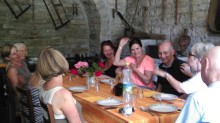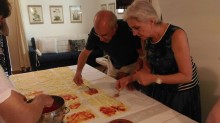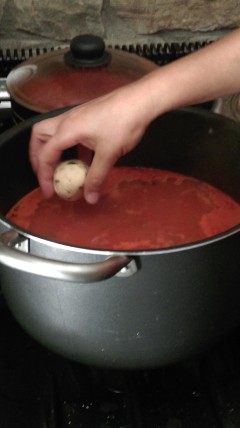The best way to let your inhibitions fly out the window and get practicing Italian is to find a place where no one speaks English and then engage in an activity.
Cooking is one of the best – this summer at Live and Learn Italian everyone enjoyed the cooking sessions so much that in 2016 there will be more opportunities woven into the programme. A festive meal around a big table with our Italian cooks and hosts, being focused on the ingredients, a relaxing and friendly atmosphere –with a bit of wine – and everyone got speaking.

We cooked in the kitchens of our hosts and in that environment were really able to get a feel of their daily lives and of the person behind the apron.
And we noticed some interesting differences in our kitchen cultures:
We were struck by how little seasoning was used.For example, a simple sugo al pomodoro:
1 garlic clove – left whole and once infused the olive oil, discarded-half a stick of celery – a whole one was deemed too overpowering-half a carrot (only if you like……)-no onions-no herbs – just some fresh basil thrown on at the table
Of course the tomatoes were fresh and if not straight from our host’s garden, from l’orto del contadino. Everyone seems to have a friendly and reliable contadino from whom to obtain home made sausages and salamis, fresh produce and of course jams and marmellata (sweet and savory preserves).And plenty of the local women make all this themselves, including their own cheese.

So, the freshness of the ingredients (pretty much organically grown and no traveling) meant that we actually tasted the food and not just the seasoning, which thus became surplus to requirements.
Recipes vary a lot – not just from region to region but village to village, family to family. Of course we have all kinds of variety in our recipes, but not in such a proprietorial way! In that place it is cooked like that……we do it like this…..My mother would never do it that way….. and the way it is done a casa sua is usually the best.
Sometimes we had difficulty getting a recipe at all – our very experienced cooks, when asked ‘how much flour’ could only reply ‘ quanto basta’…….
This became our catch phrase – ‘when it is enough’ between all the participants of 2105.
by Jenifer@ liveandlearnitalian.com
Read more
Where no one speaks English
Easter in Agnone with Jenifer: get an idea of the programme
Exploring and learning Italian: Molise
The oldest bell foundry in the world


